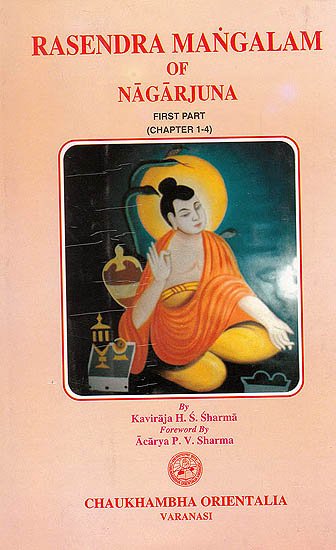Rasendramangalam of Nagarjuna
author: Kaviraja H. S. Sharma
edition: 2008, Chaukhambha Orientalia
pages: 232
ISBN-13: 9788176370905
Topic: Rasashastra
Introduction
Nagarjuna’ s Rasendramangalam was originally written in Sanskrta. The copies of this manuscript are available in Telugu, Malayalam, Devanagari and other scripts. The text was edited only once and published by l3huva nehvari Pitha, Gondal (Gujarat) in 1924. In this edition many misprints and incomplete portion of verses are kept as it is without any attempt to complete the verses. Presently the book is out of print.
The work has eight chapters. But only first four chapters were available in the published edition and manuscripts. I have compared this published edition with manuscripts obtained, from the Gujarat Ayurveda University, Jamnagar and Rajasthan Pracya Vidya Pratisthana, Government Office, Bikaner. The first four sections are ready and presented here with. English and Hindi translations and notes. However the Bikaner ms. has been mainly followed by me and the left-out portion has been completed with the other edition and Jamnagar copy.
About the Manuscript Following information on manuscripts will be of interest
1. Verses in Jamnagar copy have no serial numbers, but the verses are given chapter wise.
2. Verses in Bikaner copy are serially numbered irrespective of chapters which run unto folia 15 and verse 216. Thereafter the serial number is given according to the subject and not according to verses.
3. There are 37 folia in Jamnagar manuscript, 56 folia in Bikaner manuscript.
4. Names of drugs available in the manuscript are written in Roman script
5. Copier’s mistakes are corrected, proper titles of the subject are also supplied where the copier is silent.
6. As far as I know the remaining four chapters are available in the custody of the Welcome Institute of History of Medicine, London. NWI/2BN 183 EUSTON Road, on receiving remaining 4 chapters, the leftout project will be completed.
Authorship
There were many Nagarjunas referred to in the history of sciences of India. The originator of Mahyna cult following Bauddha Mdhyamika philosophy is referred to as Nagarjuna. He is perhaps the writer of kakaputa who seems to have followed the Bauddha cult and its theory of Prajnaparamita. The Kakaputa also refers to a conversation between Ratnaghoa and Vata yaksini which took place in the presence of Nagarjuna. Conversations between Nagarjuna and Salivahana are also quoted in Kak.aputa. Site of conversations was, Srtraila which is situated in Andhra Pradesh near Hyderabad and Nagarjunakonda.
The originator of Unyavada and Madhyamika cult under Bauddha tradition flourished in SAlivahana kingdom during 2nd century A.D. This Nagarjuna seems to be a different person from the author of Rasendramangalam. Dalhaiacarya, the commentator of Sugruta refers to one Nagarjuna as editor of Suruta. He is also a different person.
Pandit Kumarajiva has written in 401 A.D. in Sanskrta on the life of one Nagarjuna. It was translated into Chinese language and is now available. The letter written by Nagarjuna in Sanskta (Pali) entitled arya nagarjuna bodhisattva suhrllekha, was translated into Tibetan and Chinese languages. He was Arya Nagarjuna. A Prakrta story book, Lilavati quotes about Nagarjuna Pottta and Kumarila during the kingdom of atavahana. This is again a different Nagarjuna.
Nagarjuna, the author of Rasendramangaiam, is supposed to have written another work entitled Rasaratnakara. But he is not the author of Kakaaputa Tantram and Arogya Manjari, though these texts are wrongly attributed to him,
Nagarjuna, as quoted in the text of Rasendramangalam (1.1) prays, “"????”, and chapter 4-49, 728 and in his various yogas, effects of formulas were given in the name of Brahma, Viu and Rudra, etc. of Hindu cult proves him to be of HINDU DHARMIN. Therefore it is presumed that Nagarjuna, the writer of Rasendramangalam was a aiva, different from the author of Kaksaputa. Possibly he also belonged to Siddha cult. The treatise Prabandha Cintamani quotes about him. The Nagarjuna was also a disciple of Padalipta SUn. He was successful in Dhatuvada for conversion of lower metal into noble metal. He was also a good physician. He is believed to have flourished during 7-8 century A.D. He has collected few references from other authors also as on chapter: l/19,21;31154,156 and 4/37 etc.
It proves the presence of other subject experts on mercurials and mercury before and during the time of this writer so cal1d Nagarjuna.
He has given a universal factor for procuring drugs to make mercury under different processes of Khoa, Bandha, CUrna, Vedha etc. as quoted at chapter 4-78 as “Yatha-labha+usadhi-Ghrstam, Sabijam Sutabandhanam” and “Samyag guru prasadena” “Dravyaih sthavara-jangamaih” 4-81 etc. references. It supports the broad mindedness of this Nagarjuna for research work.
Let scientists apply their mind and do needful to win the poverty and ailments of mankind.
